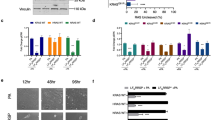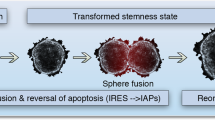Abstract
Mutations of K-ras have been found in 30–60% of colorectal carcinomas and are believed to be associated with tumor initiation, tumor progression and metastasis formation. Therefore, silencing of mutant K-ras expression has become an attractive therapeutic strategy for colorectal cancer treatment. The aim of our study was to investigate the effect of microRNA (miRNA) molecules directed against K-ras (miRNA-K-ras) on K-ras expression level and the growth of colorectal carcinoma cell line LoVo in vitro and in vivo. In addition, we evaluated electroporation as a gene delivery method for transfection of LoVo cells and tumors with plasmid DNA encoding miRNA-K-ras (pmiRNA-K-ras). Results of our study indicated that miRNAs targeting K-ras efficiently reduced K-ras expression and cell survival after in vitro electrotransfection of LoVo cells with pmiRNA-K-ras. In vivo, electroporation has proven to be a simple and efficient delivery method for local administration of pmiRNA-K-ras molecules into LoVo tumors. This therapy shows pronounced antitumor effectiveness and has no side effects. The obtained results demonstrate that electrogene therapy with miRNA-K-ras molecules can be potential therapeutic strategy for treatment of colorectal cancers harboring K-ras mutations.
This is a preview of subscription content, access via your institution
Access options
Subscribe to this journal
Receive 12 print issues and online access
$259.00 per year
only $21.58 per issue
Buy this article
- Purchase on Springer Link
- Instant access to full article PDF
Prices may be subject to local taxes which are calculated during checkout





Similar content being viewed by others
References
Friday BB, Adjei AA . K-ras as a target for cancer therapy. Biochim Biophys Acta 2005; 1756: 127–144.
Salomon DS, Brandt R, Ciardiello F, Normanno N . Epidermal growth factor-related peptides and their receptors in human malignancies. Crit Rev Oncol Hematol 1995; 19: 183–232.
Rozenblum E, Schutte M, Goggins M, Hahn SA, Panzer S, Zahurak M et al. Tumor-suppressive pathways in pancreatic carcinoma. Cancer Res 1997; 57: 1731–1734.
Andreyev HJ, Tilsed JV, Cunningham D, Sampson SA, Norman AR, Schneider HJ et al. K-ras mutations in patients with early colorectal cancers. Gut 1997; 41: 323–329.
Brink M, de Goeij AF, Weijenberg MP, Roemen GM, Lentjes MH, Pachen MM et al. K-ras oncogene mutations in sporadic colorectal cancer in The Netherlands Cohort Study. Carcinogenesis 2003; 24: 703–710.
Aviel-Ronen S, Blackhall FH, Shepherd FA, Tsao MS . K-ras mutations in non-small-cell lung carcinoma: a review. Clin Lung Cancer 2006; 8: 30–38.
Weber A, Langhanki L, Sommerer F, Markwarth A, Wittekind C, Tannapfel A . Mutations of the BRAF gene in squamous cell carcinoma of the head and neck. Oncogene 2003; 22: 4757–4759.
Brummelkamp TR, Bernards R, Agami R . Stable suppression of tumorigenicity by virus-mediated RNA interference. Cancer Cell 2002; 2: 243–247.
Chen LM, Le HY, Qin RY, Kumar M, Du ZY, Xia RJ et al. Reversal of the phenotype by K-rasval12 silencing mediated by adenovirus-delivered siRNA in human pancreatic cancer cell line Panc-1. World J Gastroenterol 2005; 11: 831–838.
Fleming JB, Shen GL, Holloway SE, Davis M, Brekken RA . Molecular consequences of silencing mutant K-ras in pancreatic cancer cells: justification for K-ras-directed therapy. Mol Cancer Res 2005; 3: 413–423.
Rejiba S, Wack S, Aprahamian M, Hajri A . K-ras oncogene silencing strategy reduces tumor growth and enhances gemcitabine chemotherapy efficacy for pancreatic cancer treatment. Cancer Sci 2007; 98: 1128–1136.
Wang W, Wang CY, Dong JH, Chen X, Zhang M, Zhao G . Identification of effective siRNA against K-ras in human pancreatic cancer cell line MiaPaCa-2 by siRNA expression cassette. World J Gastroenterol 2005; 11: 2026–2031.
Zhu H, Liang ZY, Ren XY, Liu TH . Small interfering RNAs targeting mutant K-ras inhibit human pancreatic carcinoma cells growth in vitro and in vivo. Cancer Biol Ther 2006; 5: 1693–1698.
Sersa G, Cemazar M, Miklavcic D, Rudolf Z . Electrochemotherapy of tumours. Radiol Oncol 2006; 40: 163–174.
Miklavcic D, Corovic S, Pucihar G, Pavšelj N . Importance of tumour coverage by sufficiently high local electric field for effective electrochemotherapy. Eur J Cancer Suppl 2006; 4: 45–51.
Teissie J, Escoffre JM, Rols MP, Golzio M . Time dependence of electric field effects on cell membranes. A review for a critical selection of pulse duration for therapeutical applications. Radiol Oncol 2008; 42: 196–206.
Mir LM, Moller PH, Andre F, Gehl J . Electric pulse-mediated gene delivery to various animal tissues. Adv Genet 2005; 54: 83–114.
Cemazar M, Golzio M, Sersa G, Rols MP, Teissie J . Electrically-assisted nucleic acids delivery to tissues in vivo: where do we stand? Curr Pharm Des 2006; 12: 3817–3825.
Heller LC, Heller R . In vivo electroporation for gene therapy. Hum Gene Ther 2006; 17: 890–897.
Cemazar M, Sersa G . Electrotransfer of therapeutic molecules into tissues. Curr Opin Mol Ther 2007; 9: 554–562.
Bodles-Brakhop AM, Heller R, Draghia-Akli R . Electroporation for the delivery of DNA-based vaccines and immunotherapeutics: current clinical developments. Mol Ther 2009; 17: 585–592.
Daud AI, DeConti RC, Andrews S, Urbas P, Riker AI, Sondak VK et al. Phase I trial of interleukin-12 plasmid electroporation in patients with metastatic melanoma. J Clin Oncol 2008; 26: 5896–5903.
Deng G, Bell I, Crawley S, Gum J, Terdiman JP, Allen BA et al. BRAF mutation is frequently present in sporadic colorectal cancer with methylated hMLH1, but not in hereditary nonpolyposis colorectal cancer. Clin Cancer Res 2004; 10: 191–195.
Gayet J, Zhou XP, Duval A, Rolland S, Hoang JM, Cottu P et al. Extensive characterization of genetic alterations in a series of human colorectal cancer cell lines. Oncogene 2001; 20: 5025–5032.
Ogino S, Kawasaki T, Brahmandam M, Yan L, Cantor M, Namgyal C et al. Sensitive sequencing method for KRAS mutation detection by pyrosequencing. J Mol Diagn 2005; 7: 413–421.
Khanna M, Park P, Zirvi M, Cao W, Picon A, Day J et al. Multiplex PCR/LDR for detection of K-ras mutations in primary colon tumors. Oncogene 1999; 18: 27–38.
Cemazar M, Sersa G, Wilson J, Tozer GM, Hart SL, Grosel A et al. Effective gene transfer to solid tumors using different nonviral gene delivery techniques: electroporation, liposomes, and integrin-targeted vector. Cancer Gene Ther 2002; 9: 399–406.
Teicher BA . In vivo tumor response end points. In: Teicher, BA (ed). Tumor Models in Cancer Research. Humana Press Totowa: New Jersey, 2002. pp 593–616.
Bartlett DW, Davis ME . Insights into the kinetics of siRNA-mediated gene silencing from live-cell and live-animal bioluminescent imaging. Nucleic Acids Res 2006; 34: 322–333.
Chiu YL, Rana TM . RNAi in human cells: basic structural and functional features of small interferin RNA. Mol Cell 2002; 10: 549–561.
Caplen NJ, Parrish S, Imani F, Fire A, Morgan RA . Specific inhibition of gene expression by small double-stranded RNAs in invertebrate and vertebrate systems. Proc Natl Acad Sci USA 2001; 98: 9742–9747.
Dykxhoorn DM, Palliser D, Lieberman J . The silent treatment: siRNAs as small molecule drugs. Gene Ther 2006; 13: 541–552.
Golzio M, Mazzolini L, Ledoux A, Paganin A, Izard M, Hellaudais L et al. In vivo gene silencing in solid tumors by targeted electrically mediated siRNA delivery. Gene Ther 2007; 14: 752–759.
Mesojednik S, Kamensek U, Cemazar M . Evaluation of shRNA-mediated gene silencing by electoporation in LPB fibrosarcoma cells. Radiol Oncol 2008; 42: 82–92.
Paganin-Gioanni A, Bellard E, Couderc B, Teissie J, Golzio M . Tracking in vitro and in vivo siRNA electrotransfer in tumor cells. J RNAi Gene Silencing 2008; 4: 281–288.
Nakai N, Kishida T, Shin-Ya M, Imanishi J, Ueda Y, Kishimoto S et al. Therapeutic RNA interference of malignant melanoma by electrotransfer of small interfering RNA targeting Mitf. Gene Ther 2007; 14: 357–365.
Takahashi Y, Nishikawa M, Takakura Y . Suppression of tumor growth by intratumoral injection of short hairpin RNA-expressing plasmid DNA targeting beta-catenin or hypoxia-inducible factor 1alpha. J Control Release 2006; 116: 90–95.
Zhang L, Gao L, Li Y, Lin G, Shao Y, Ji K et al. Effects of plasmid-based Stat3-specific short hairpin RNA and GRIM-19 on PC-3M tumor cell growth. Clin Cancer Res 2008; 14: 559–568.
Escoffre JM, Portet T, Wasungu L, Teissie J, Dean D, Rols MP . What is (still not) known of the mechanism by which electroporation mediates gene transfer and expression in cells and tissues. Mol Biotechnol 2009; 41: 286–295.
Heller LC, Coppola D . Electrically mediated delivery of vector plasmid DNA elicits an antitumor effect. Gene Ther 2002; 9: 1321–1325.
Acknowledgements
We acknowledge the financial support from the state budget by the Slovenian Research Agency (programme No. P3-0003; project No. J3-7044 and J3-0485).
Author information
Authors and Affiliations
Corresponding author
Ethics declarations
Competing interests
The authors declare no conflict of interest.
Rights and permissions
About this article
Cite this article
Vidic, S., Markelc, B., Sersa, G. et al. MicroRNAs targeting mutant K-ras by electrotransfer inhibit human colorectal adenocarcinoma cell growth in vitro and in vivo. Cancer Gene Ther 17, 409–419 (2010). https://doi.org/10.1038/cgt.2009.87
Received:
Revised:
Accepted:
Published:
Issue Date:
DOI: https://doi.org/10.1038/cgt.2009.87
Keywords
This article is cited by
-
Translational control of enzyme scavenger expression with toxin-induced micro RNA switches
Scientific Reports (2021)
-
Cytosolic DNA Sensor Upregulation Accompanies DNA Electrotransfer in B16.F10 Melanoma Cells
Molecular Therapy - Nucleic Acids (2016)
-
Tumor radiosensitization by gene therapy against endoglin
Cancer Gene Therapy (2016)
-
Gene electrotransfer of plasmid AMEP, an integrin-targeted therapy, has antitumor and antiangiogenic action in murine B16 melanoma
Gene Therapy (2015)
-
Different Incubation Times of Cells After Gene Electrotransfer in Fetal Bovine Serum Affect Cell Viability, but Not Transfection Efficiency
The Journal of Membrane Biology (2014)



